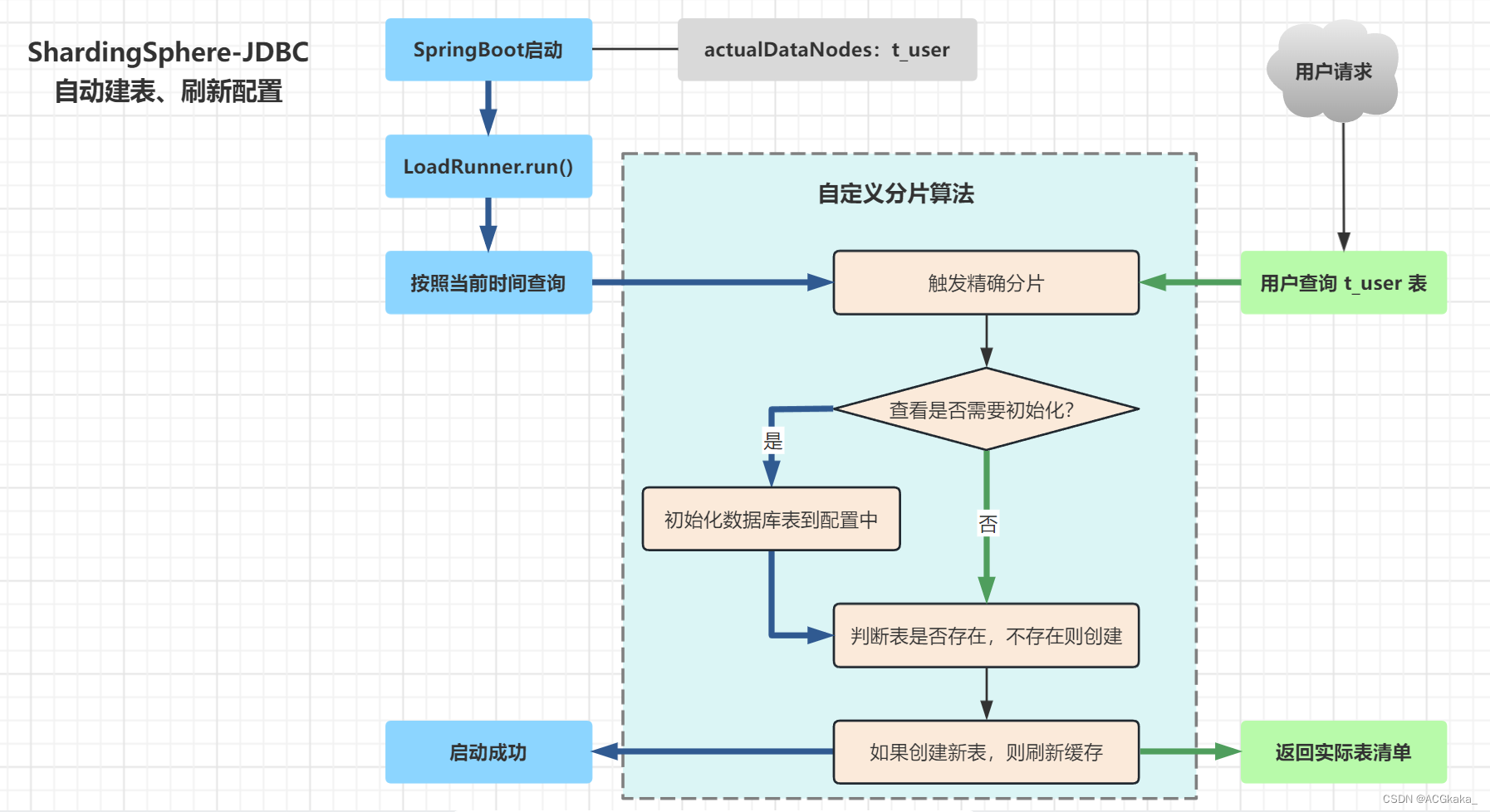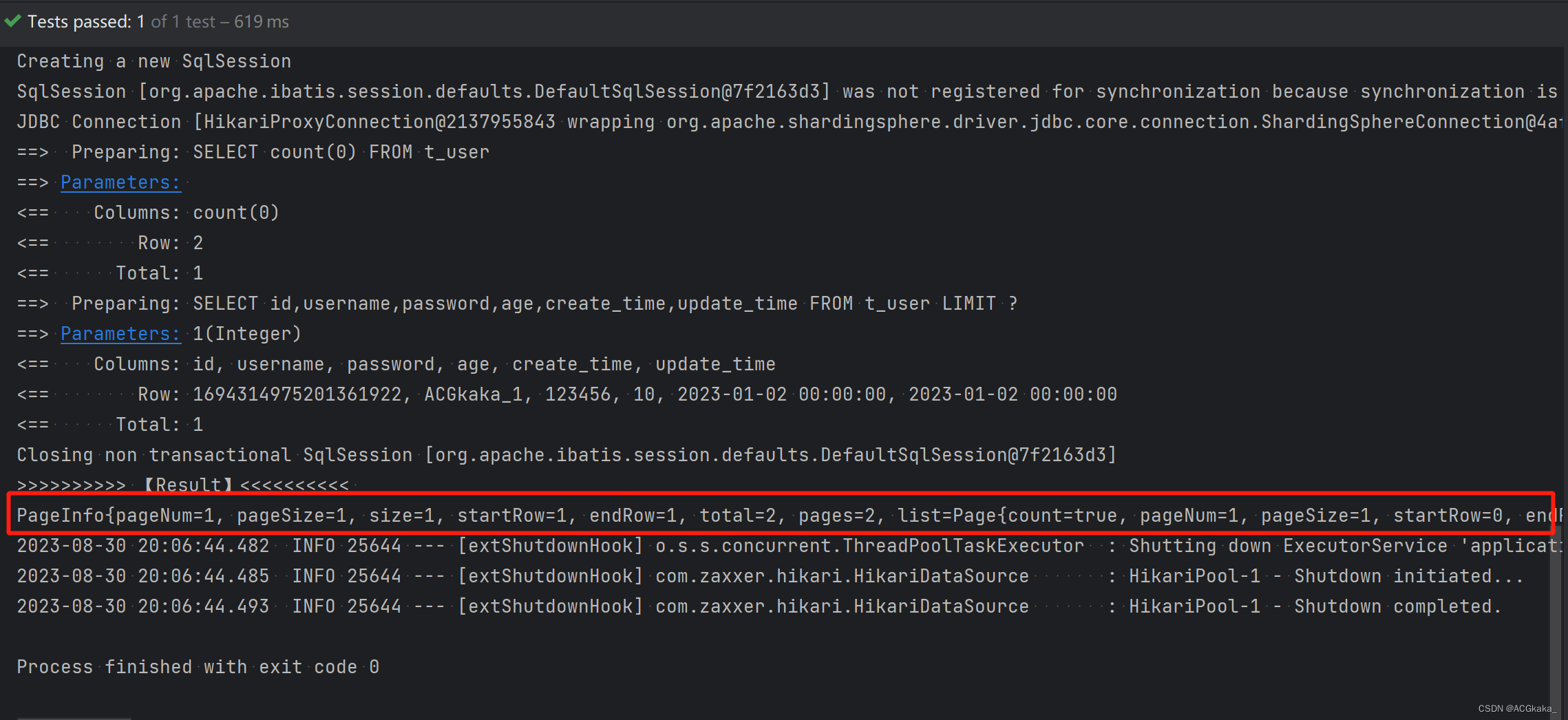目录
-
- 一、简介
- 二、Maven依赖
- 三、配置文件
-
- application.yml
- sharding.yaml
- 四、代码实现
-
- 1.自动建表、自动刷新节点思路
- 2.创建表结构
- 3.TimeShardingAlgorithm.java 分片算法类
- 4.ShardingAlgorithmTool.java 分片工具类
- 5.ShardingTablesLoadRunner.java 初始化缓存类
- 6.SpringUtil.java Spring工具类
- 五、测试
-
- 1.测试代码
- 2.测试结果
- 六、代码地址

- 官网地址: https://shardingsphere.apache.org/
- GitHub: https://github.com/apache/shardingsphere
- 官方示例:https://github.com/apache/shardingsphere/tree/master/examples
- 中文社区: https://community.sphere-ex.com/
- 5.3.0 官方文档: https://shardingsphere.apache.org/document/5.3.0/cn/overview/
补充:如果要看 5.4.0 的文档,直接把地址中的 5.3.0 改为 5.4.0 即可,以此类推。
一、简介
背景: 之前使用 ShardingSphere-JDBC 的 5.1.0 版本进行数据分片,后来开源组件扫描发现 5.1.0 版本存在如下漏洞,需要升级到 5.3.0 及以上版本:
- Apache ShardingSphere远程代码执行漏洞(CVE-2020-1947): Apache ShardingSphere存在YAML解析远程代码执行漏洞,开发人员直接使用unmarshal方法对输入的YAML直接进行解析,没有做校验,攻击者在相应漏洞触发点输入payload即可完成攻击。
升级到5.3.0 改动还是很大的,新版本移除了 Spring 全部依赖和配置支持,引入了 ShardingSphereDriver 数据库驱动,也就意味着需要使用新的配置方式。
注意:由于 Druid 集成过程中遇到些问题,本文集成内容未使用 Druid 连接池,如果后续集成完毕,会再补充一篇文章说明。
二、Maven依赖
<!-- Sharding-JDBC -->
<dependency>
<groupId>org.apache.shardingsphere</groupId>
<artifactId>shardingsphere-jdbc-core</artifactId>
<version>5.3.0</version>
</dependency>
三、配置文件
application.yml
server:
port: 8081
spring:
### 处理连接池冲突 #####
main:
allow-bean-definition-overriding: true
datasource:
driver-class-name: org.apache.shardingsphere.driver.ShardingSphereDriver
url: jdbc:shardingsphere:classpath:sharding.yaml
# mybatis-plus
mybatis-plus:
mapper-locations: classpath*:/mapper/*Mapper.xml
# 实体扫描,多个package用逗号或者分号分隔
typeAliasesPackage: com.demo.*.entity
# 测试环境打印sql
configuration:
log-impl: org.apache.ibatis.logging.stdout.StdOutImpl
pagehelper:
helperDialect: postgresql
my:
sharding:
create-table:
url: jdbc:mysql://localhost:3306/mydb?useUnicode=true&characterEncoding=UTF-8&serverTimezone=Asia/Shanghai
username: root
password: root
sharding.yaml
#
# Licensed to the Apache Software Foundation (ASF) under one or more
# contributor license agreements. See the NOTICE file distributed with
# this work for additional information regarding copyright ownership.
# The ASF licenses this file to You under the Apache License, Version 2.0
# (the "License"); you may not use this file except in compliance with
# the License. You may obtain a copy of the License at
#
# http://www.apache.org/licenses/LICENSE-2.0
#
# Unless required by applicable law or agreed to in writing, software
# distributed under the License is distributed on an "AS IS" BASIS,
# WITHOUT WARRANTIES OR CONDITIONS OF ANY KIND, either express or implied.
# See the License for the specific language governing permissions and
# limitations under the License.
#
dataSources:
ds:
dataSourceClassName: com.zaxxer.hikari.HikariDataSource
driverClassName: com.mysql.jdbc.Driver
jdbcUrl: jdbc:mysql://localhost:3306/mydb?useUnicode=true&characterEncoding=UTF-8&serverTimezone=Asia/Shanghai
username: root
password: root
rules:
- !SHARDING
tables:
t_user:
actualDataNodes: ds.t_user
tableStrategy:
standard:
shardingColumn: create_time
shardingAlgorithmName: auto-custom
shardingAlgorithms:
auto-custom:
type: CLASS_BASED
props:
strategy: standard
algorithmClassName: com.demo.module.config.sharding.TimeShardingAlgorithm
# auto-interval:
# type: AUTO_INTERVAL
# props:
# datetime-lower: '2023-01-01 00:00:00'
# datetime-upper: '2023-12-01 00:00:00'
# # 60 * 60 * 24 * 30=30天
# sharding-seconds: '2592000'
# interval:
# type: INTERVAL
# props:
# datetime-pattern: 'yyyy-MM'
# datetime-lower: '2023-01'
# datetime-upper: '2023-12'
# sharding-suffix-pattern: 'yyyyMM'
# # 间隔大小
# datetime-interval-amount: 1
# datetime-interval-unit: 'Months'
props:
sql-show: false
四、代码实现
1.自动建表、自动刷新节点思路
大概思路为:
- 配置: 编写配置的时候,我们只编写逻辑表 t_user。
- 启动初始化: 在启动后执行脚本 LoadRunner.run() 的时候,触发精确分片来初始化数据库中表名到配置中。
- 建表并刷新配置: 如果初始化后的配置中不存在表名,则创建表并刷新分表配置。

2.创建表结构
-- ------------------------------
-- 用户表
-- ------------------------------
CREATE TABLE t_user (
id bigint(16) NOT NULL COMMENT '主键',
username varchar(64) NOT NULL COMMENT '用户名',
password varchar(64) NOT NULL COMMENT '密码',
age int(8) NOT NULL COMMENT '年龄',
create_time timestamp NOT NULL DEFAULT CURRENT_TIMESTAMP COMMENT '创建时间',
update_time timestamp NOT NULL DEFAULT CURRENT_TIMESTAMP ON UPDATE CURRENT_TIMESTAMP COMMENT '更新时间',
PRIMARY KEY (id)
) ENGINE=InnoDB DEFAULT CHARSET=utf8 COMMENT='用户表';
-- ------------------------------
-- 用户表202201
-- ------------------------------
CREATE TABLE t_user_202201 (
id bigint(16) NOT NULL COMMENT '主键',
username varchar(64) NOT NULL COMMENT '用户名',
password varchar(64) NOT NULL COMMENT '密码',
age int(8) NOT NULL COMMENT '年龄',
create_time timestamp NOT NULL DEFAULT CURRENT_TIMESTAMP COMMENT '创建时间',
update_time timestamp NOT NULL DEFAULT CURRENT_TIMESTAMP ON UPDATE CURRENT_TIMESTAMP COMMENT '更新时间',
PRIMARY KEY (id)
) ENGINE=InnoDB DEFAULT CHARSET=utf8 COMMENT='用户表202201';
3.TimeShardingAlgorithm.java 分片算法类
/*
* Licensed to the Apache Software Foundation (ASF) under one or more
* contributor license agreements. See the NOTICE file distributed with
* this work for additional information regarding copyright ownership.
* The ASF licenses this file to You under the Apache License, Version 2.0
* (the "License"); you may not use this file except in compliance with
* the License. You may obtain a copy of the License at
*
* http://www.apache.org/licenses/LICENSE-2.0
*
* Unless required by applicable law or agreed to in writing, software
* distributed under the License is distributed on an "AS IS" BASIS,
* WITHOUT WARRANTIES OR CONDITIONS OF ANY KIND, either express or implied.
* See the License for the specific language governing permissions and
* limitations under the License.
*/
package com.demo.module.config.sharding;
import com.google.common.collect.Range;
import lombok.Getter;
import lombok.extern.slf4j.Slf4j;
import org.apache.shardingsphere.sharding.api.sharding.ShardingAutoTableAlgorithm;
import org.apache.shardingsphere.sharding.api.sharding.standard.PreciseShardingValue;
import org.apache.shardingsphere.sharding.api.sharding.standard.RangeShardingValue;
import org.apache.shardingsphere.sharding.api.sharding.standard.StandardShardingAlgorithm;
import java.time.LocalDateTime;
import java.time.format.DateTimeFormatter;
import java.util.*;
import java.util.function.Function;
import java.util.stream.Collectors;
/**
* <p> @Title TimeShardingAlgorithm
* <p> @Description 分片算法,按月分片
*
* @author ACGkaka
* @date 2022/12/20 11:33
*/
@Slf4j
public final class TimeShardingAlgorithm implements StandardShardingAlgorithm<LocalDateTime>, ShardingAutoTableAlgorithm {
/**
* 分片时间格式
*/
private static final DateTimeFormatter TABLE_SHARD_TIME_FORMATTER = DateTimeFormatter.ofPattern("yyyyMM");
/**
* 完整时间格式
*/
private static final DateTimeFormatter DATE_TIME_FORMATTER = DateTimeFormatter.ofPattern("yyyyMMdd HH:mm:ss");
/**
* 表分片符号,例:t_contract_202201 中,分片符号为 "_"
*/
private final String TABLE_SPLIT_SYMBOL = "_";
@Getter
private Properties props;
@Getter
private int autoTablesAmount;
@Override
public void init(final Properties props) {
this.props = props;
}
@Override
public String doSharding(final Collection<String> availableTargetNames, final PreciseShardingValue<LocalDateTime> preciseShardingValue) {
String logicTableName = preciseShardingValue.getLogicTableName();
/// 打印分片信息
log.info(">>>>>>>>>> 【INFO】精确分片,节点配置表名:{}", availableTargetNames);
LocalDateTime dateTime = preciseShardingValue.getValue();
String resultTableName = logicTableName + "_" + dateTime.format(TABLE_SHARD_TIME_FORMATTER);
// 检查是否需要初始化
if (availableTargetNames.size() == 1) {
// 如果只有一个表,说明需要获取所有表名
List<String> allTableNameBySchema = ShardingAlgorithmTool.getAllTableNameBySchema(logicTableName);
availableTargetNames.clear();
availableTargetNames.addAll(allTableNameBySchema);
autoTablesAmount = allTableNameBySchema.size();
return resultTableName;
}
return getShardingTableAndCreate(logicTableName, resultTableName, availableTargetNames);
}
@Override
public Collection<String> doSharding(final Collection<String> availableTargetNames, final RangeShardingValue<LocalDateTime> rangeShardingValue) {
String logicTableName = rangeShardingValue.getLogicTableName();
/// 打印分片信息
log.info(">>>>>>>>>> 【INFO】范围分片,节点配置表名:{}", availableTargetNames);
// between and 的起始值
Range<LocalDateTime> valueRange = rangeShardingValue.getValueRange();
boolean hasLowerBound = valueRange.hasLowerBound();
boolean hasUpperBound = valueRange.hasUpperBound();
// 获取最大值和最小值
LocalDateTime min = hasLowerBound ? valueRange.lowerEndpoint() :getLowerEndpoint(availableTargetNames);
LocalDateTime max = hasUpperBound ? valueRange.upperEndpoint() :getUpperEndpoint(availableTargetNames);
// 循环计算分表范围
Set<String> resultTableNames = new LinkedHashSet<>();
while (min.isBefore(max) || min.equals(max)) {
String tableName = logicTableName + TABLE_SPLIT_SYMBOL + min.format(TABLE_SHARD_TIME_FORMATTER);
resultTableNames.add(tableName);
min = min.plusMinutes(1);
}
return getShardingTablesAndCreate(logicTableName, resultTableNames, availableTargetNames);
}
@Override
public String getType() {
return "AUTO_CUSTOM";
}
// --------------------------------------------------------------------------------------------------------------
// 私有方法
// --------------------------------------------------------------------------------------------------------------
/**
* 检查分表获取的表名是否存在,不存在则自动建表
*
* @param logicTableName 逻辑表
* @param resultTableNames 真实表名,例:t_user_202201
* @param availableTargetNames 可用的数据库表名
* @return 存在于数据库中的真实表名集合
*/
public Set<String> getShardingTablesAndCreate(String logicTableName, Collection<String> resultTableNames, Collection<String> availableTargetNames) {
return resultTableNames.stream().map(o -> getShardingTableAndCreate(logicTableName, o, availableTargetNames)).collect(Collectors.toSet());
}
/**
* 检查分表获取的表名是否存在,不存在则自动建表
* @param logicTableName 逻辑表
* @param resultTableName 真实表名,例:t_user_202201
* @return 确认存在于数据库中的真实表名
*/
private String getShardingTableAndCreate(String logicTableName, String resultTableName, Collection<String> availableTargetNames) {
// 缓存中有此表则返回,没有则判断创建
if (availableTargetNames.contains(resultTableName)) {
return resultTableName;
} else {
// 检查分表获取的表名不存在,需要自动建表
boolean isSuccess = ShardingAlgorithmTool.createShardingTable(logicTableName, resultTableName);
if (isSuccess) {
// 如果建表成功,需要更新缓存
availableTargetNames.add(resultTableName);
autoTablesAmount++;
return resultTableName;
} else {
// 如果建表失败,返回逻辑空表
return logicTableName;
}
}
}
/**
* 获取 最小分片值
* @param tableNames 表名集合
* @return 最小分片值
*/
private LocalDateTime getLowerEndpoint(Collection<String> tableNames) {
Optional<LocalDateTime> optional = tableNames.stream()
.map(o -> LocalDateTime.parse(o.replace(TABLE_SPLIT_SYMBOL, "") + "01 00:00:00", DATE_TIME_FORMATTER))
.min(Comparator.comparing(Function.identity()));
if (optional.isPresent()) {
return optional.get();
} else {
log.error(">>>>>>>>>> 【ERROR】获取数据最小分表失败,请稍后重试,tableName:{}", tableNames);
throw new IllegalArgumentException("获取数据最小分表失败,请稍后重试");
}
}
/**
* 获取 最大分片值
* @param tableNames 表名集合
* @return 最大分片值
*/
private LocalDateTime getUpperEndpoint(Collection<String> tableNames) {
Optional<LocalDateTime> optional = tableNames.stream()
.map(o -> LocalDateTime.parse(o.replace(TABLE_SPLIT_SYMBOL, "") + "01 00:00:00", DATE_TIME_FORMATTER))
.max(Comparator.comparing(Function.identity()));
if (optional.isPresent()) {
return optional.get();
} else {
log.error(">>>>>>>>>> 【ERROR】获取数据最大分表失败,请稍后重试,tableName:{}", tableNames);
throw new IllegalArgumentException("获取数据最大分表失败,请稍后重试");
}
}
}
4.ShardingAlgorithmTool.java 分片工具类
package com.demo.module.config.sharding;
import com.demo.module.utils.SpringUtil;
import lombok.extern.slf4j.Slf4j;
import org.apache.commons.lang3.StringUtils;
import org.apache.shardingsphere.driver.jdbc.core.datasource.ShardingSphereDataSource;
import org.apache.shardingsphere.infra.config.rule.RuleConfiguration;
import org.apache.shardingsphere.infra.metadata.ShardingSphereMetaData;
import org.apache.shardingsphere.mode.manager.ContextManager;
import org.apache.shardingsphere.sharding.api.config.ShardingRuleConfiguration;
import org.apache.shardingsphere.sharding.api.config.rule.ShardingTableRuleConfiguration;
import org.springframework.core.env.Environment;
import org.springframework.util.ReflectionUtils;
import java.io.File;
import java.lang.reflect.Field;
import java.sql.*;
import java.time.YearMonth;
import java.time.format.DateTimeFormatter;
import java.util.*;
/**
* <p> @Title ShardingAlgorithmTool
* <p> @Description 按月分片算法工具
*
* @author ACGkaka
* @date 2022/12/20 14:03
*/
@Slf4j
public class ShardingAlgorithmTool {
/** 表分片符号,例:t_user_202201 中,分片符号为 "_" */
private static final String TABLE_SPLIT_SYMBOL = "_";
/** 数据库配置 */
private static final Environment ENV = SpringUtil.getApplicationContext().getEnvironment();
private static final String DATASOURCE_URL = ENV.getProperty("my.sharding.create-table.url");
private static final String DATASOURCE_USERNAME = ENV.getProperty("my.sharding.create-table.username");
private static final String DATASOURCE_PASSWORD = ENV.getProperty("my.sharding.create-table.password");
/** 配置文件路径 */
private static final String CONFIG_FILE = "sharding-tables.yaml";
/**
* 获取所有表名
* @return 表名集合
* @param logicTableName 逻辑表
*/
public static List<String> getAllTableNameBySchema(String logicTableName) {
List<String> tableNames = new ArrayList<>();
if (StringUtils.isEmpty(DATASOURCE_URL) || StringUtils.isEmpty(DATASOURCE_USERNAME) || StringUtils.isEmpty(DATASOURCE_PASSWORD)) {
log.error(">>>>>>>>>> 【ERROR】数据库连接配置有误,请稍后重试,URL:{}, username:{}, password:{}", DATASOURCE_URL, DATASOURCE_USERNAME, DATASOURCE_PASSWORD);
throw new IllegalArgumentException("数据库连接配置有误,请稍后重试");
}
try (Connection conn = DriverManager.getConnection(DATASOURCE_URL, DATASOURCE_USERNAME, DATASOURCE_PASSWORD);
Statement st = conn.createStatement()) {
try (ResultSet rs = st.executeQuery("show TABLES like '" + logicTableName + TABLE_SPLIT_SYMBOL + "%'")) {
while (rs.next()) {
String tableName = rs.getString(1);
// 匹配分表格式 例:^(t\_contract_\d{6})$
if (tableName != null && tableName.matches(String.format("^(%s\\d{6})$", logicTableName + TABLE_SPLIT_SYMBOL))) {
tableNames.add(rs.getString(1));
}
}
}
} catch (SQLException e) {
log.error(">>>>>>>>>> 【ERROR】数据库连接失败,请稍后重试,原因:{}", e.getMessage(), e);
throw new IllegalArgumentException("数据库连接失败,请稍后重试");
}
return tableNames;
}
// --------------------------------------------------------------------------------------------------------------
// 私有方法
// --------------------------------------------------------------------------------------------------------------
/**
* 获取数据源
*/
// private static Map<String, DataSource> getDataSourceMap() {
// return getActualDataSources().entrySet().stream().filter(entry -> ACTUAL_DATA_SOURCE_NAMES.contains(entry.getKey())).collect(Collectors.toMap(Map.Entry::getKey, Map.Entry::getValue));
// }
/**
* 获取数据源配置
*/
private static File getShardingYAMLFile() {
return new File(Objects.requireNonNull(
ShardingAlgorithmTool.class.getClassLoader().getResource(CONFIG_FILE), String.format("File %s is not existed.", CONFIG_FILE)).getFile());
}
/**
* 刷新ActualDataNodes
*/
private static void updateShardRuleActualDataNodes(ShardingSphereDataSource dataSource, String logicTableName, String newActualDataNodes) throws NoSuchFieldException {
// Context manager.
Field contextManagerField = dataSource.getClass().getDeclaredField("contextManager");
ContextManager contextManager = (ContextManager) ReflectionUtils.getField(contextManagerField, dataSource);
// Rule configuration.
ShardingSphereMetaData shardingSphereMetaData = contextManager
.getMetaDataContexts()
.getMetaData();
Collection<RuleConfiguration> newRuleConfigList = new LinkedList<>();
Collection<RuleConfiguration> oldRuleConfigList = shardingSphereMetaData
.getGlobalRuleMetaData()
.getConfigurations();
for (RuleConfiguration oldRuleConfig : oldRuleConfigList) {
if (oldRuleConfig instanceof ShardingRuleConfiguration) {
// Algorithm provided sharding rule configuration
ShardingRuleConfiguration oldAlgorithmConfig = (ShardingRuleConfiguration) oldRuleConfig;
ShardingRuleConfiguration newAlgorithmConfig = new ShardingRuleConfiguration();
// Sharding table rule configuration Collection
Collection<ShardingTableRuleConfiguration> newTableRuleConfigList = new LinkedList<>();
Collection<ShardingTableRuleConfiguration> oldTableRuleConfigList = oldAlgorithmConfig.getTables();
oldTableRuleConfigList.forEach(oldTableRuleConfig -> {
if (logicTableName.equals(oldTableRuleConfig.getLogicTable())) {
ShardingTableRuleConfiguration newTableRuleConfig = new ShardingTableRuleConfiguration(oldTableRuleConfig.getLogicTable(), newActualDataNodes);
newTableRuleConfig.setTableShardingStrategy(oldTableRuleConfig.getTableShardingStrategy());
newTableRuleConfig.setDatabaseShardingStrategy(oldTableRuleConfig.getDatabaseShardingStrategy());
newTableRuleConfig.setKeyGenerateStrategy(oldTableRuleConfig.getKeyGenerateStrategy());
newTableRuleConfigList.add(newTableRuleConfig);
} else {
newTableRuleConfigList.add(oldTableRuleConfig);
}
});
newAlgorithmConfig.setTables(newTableRuleConfigList);
newAlgorithmConfig.setAutoTables(oldAlgorithmConfig.getAutoTables());
newAlgorithmConfig.setBindingTableGroups(oldAlgorithmConfig.getBindingTableGroups());
newAlgorithmConfig.setBroadcastTables(oldAlgorithmConfig.getBroadcastTables());
newAlgorithmConfig.setDefaultDatabaseShardingStrategy(oldAlgorithmConfig.getDefaultDatabaseShardingStrategy());
newAlgorithmConfig.setDefaultTableShardingStrategy(oldAlgorithmConfig.getDefaultTableShardingStrategy());
newAlgorithmConfig.setDefaultKeyGenerateStrategy(oldAlgorithmConfig.getDefaultKeyGenerateStrategy());
newAlgorithmConfig.setDefaultShardingColumn(oldAlgorithmConfig.getDefaultShardingColumn());
newAlgorithmConfig.setShardingAlgorithms(oldAlgorithmConfig.getShardingAlgorithms());
newAlgorithmConfig.setKeyGenerators(oldAlgorithmConfig.getKeyGenerators());
newRuleConfigList.add(newAlgorithmConfig);
}
}
// update context
String schemaName = "logic_db";
contextManager.alterRuleConfiguration(schemaName, newRuleConfigList);
}
/**
* 创建分表2
* @param logicTableName 逻辑表
* @param resultTableName 真实表名,例:t_user_202201
* @return 创建结果(true创建成功,false未创建)
*/
public static boolean createShardingTable(String logicTableName, String resultTableName) {
// 根据日期判断,当前月份之后分表不提前创建
String month = resultTableName.replace(logicTableName + TABLE_SPLIT_SYMBOL,"");
YearMonth shardingMonth = YearMonth.parse(month, DateTimeFormatter.ofPattern("yyyyMM"));
if (shardingMonth.isAfter(YearMonth.now())) {
return false;
}
synchronized (logicTableName.intern()) {
// 缓存中无此表,则建表并添加缓存
executeSql(Collections.singletonList("CREATE TABLE IF NOT EXISTS " + resultTableName + " LIKE " + logicTableName + ";"));
}
return true;
}
/**
* 执行SQL
* @param sqlList SQL集合
*/
private static void executeSql(List<String> sqlList) {
if (StringUtils.isEmpty(DATASOURCE_URL) || StringUtils.isEmpty(DATASOURCE_USERNAME) || StringUtils.isEmpty(DATASOURCE_PASSWORD)) {
log.error(">>>>>>>>>> 【ERROR】数据库连接配置有误,请稍后重试,URL:{}, username:{}, password:{}", DATASOURCE_URL, DATASOURCE_USERNAME, DATASOURCE_PASSWORD);
throw new IllegalArgumentException("数据库连接配置有误,请稍后重试");
}
try (Connection conn = DriverManager.getConnection(DATASOURCE_URL, DATASOURCE_USERNAME, DATASOURCE_PASSWORD)) {
try (Statement st = conn.createStatement()) {
conn.setAutoCommit(false);
for (String sql : sqlList) {
st.execute(sql);
}
} catch (Exception e) {
conn.rollback();
log.error(">>>>>>>>>> 【ERROR】数据表创建执行失败,请稍后重试,原因:{}", e.getMessage(), e);
throw new IllegalArgumentException("数据表创建执行失败,请稍后重试");
}
} catch (SQLException e) {
log.error(">>>>>>>>>> 【ERROR】数据库连接失败,请稍后重试,原因:{}", e.getMessage(), e);
throw new IllegalArgumentException("数据库连接失败,请稍后重试");
}
}
}
5.ShardingTablesLoadRunner.java 初始化缓存类
package com.demo.module.config.sharding;
import com.baomidou.mybatisplus.core.conditions.query.LambdaQueryWrapper;
import com.demo.module.entity.User;
import com.demo.module.service.UserService;
import lombok.extern.slf4j.Slf4j;
import org.springframework.boot.CommandLineRunner;
import org.springframework.core.annotation.Order;
import org.springframework.stereotype.Component;
import javax.annotation.Resource;
import java.time.LocalDateTime;
/**
* <p> @Title ShardingTablesLoadRunner
* <p> @Description 项目启动后,读取已有分表,进行缓存
*
* @author ACGkaka
* @date 2022/12/20 15:41
*/
@Slf4j
@Order(value = 1) // 数字越小,越先执行
@Component
public class ShardingTablesLoadRunner implements CommandLineRunner {
@Resource
private UserService userService;
@Override
public void run(String... args) {
// 读取已有分表,进行缓存
LambdaQueryWrapper<User> queryWrapper = new LambdaQueryWrapper<>();
queryWrapper.eq(User::getCreateTime, LocalDateTime.now()).last("limit 1");
userService.list(queryWrapper);
log.info(">>>>>>>>>> 【ShardingTablesLoadRunner】缓存已有分表成功 <<<<<<<<<<");
}
}
6.SpringUtil.java Spring工具类
package com.demo.module.utils;
import org.springframework.beans.BeansException;
import org.springframework.context.ApplicationContext;
import org.springframework.context.ApplicationContextAware;
import org.springframework.core.env.Environment;
import org.springframework.stereotype.Component;
/**
* <p> @Title SpringUtil
* <p> @Description Spring工具类
*
* @author ACGkaka
* @date 2022/12/20 14:39
*/
@Component
public class SpringUtil implements ApplicationContextAware {
private static ApplicationContext applicationContext = null;
@Override
public void setApplicationContext(ApplicationContext applicationContext) throws BeansException {
SpringUtil.applicationContext = applicationContext;
}
public static ApplicationContext getApplicationContext() {
return SpringUtil.applicationContext;
}
public static <T> T getBean(Class<T> cla) {
return applicationContext.getBean(cla);
}
public static <T> T getBean(String name, Class<T> cal) {
return applicationContext.getBean(name, cal);
}
public static String getProperty(String key) {
return applicationContext.getBean(Environment.class).getProperty(key);
}
}
五、测试
1.测试代码
package com.demo;
import com.demo.module.entity.User;
import com.demo.module.service.UserService;
import com.github.pagehelper.PageHelper;
import com.github.pagehelper.PageInfo;
import org.junit.jupiter.api.Test;
import org.springframework.beans.factory.annotation.Autowired;
import org.springframework.boot.test.context.SpringBootTest;
import java.time.LocalDateTime;
import java.time.format.DateTimeFormatter;
import java.util.ArrayList;
import java.util.List;
@SpringBootTest
class SpringbootDemoApplicationTests {
private final DateTimeFormatter DATE_TIME_FORMATTER = DateTimeFormatter.ofPattern("yyyy-MM-dd HH:mm:ss");
@Autowired
private UserService userService;
@Test
void saveTest() {
List<User> user1s = new ArrayList<>(3);
LocalDateTime time1 = LocalDateTime.parse("2022-01-01 00:00:00", DATE_TIME_FORMATTER);
LocalDateTime time2 = LocalDateTime.parse("2022-02-01 00:00:00", DATE_TIME_FORMATTER);
user1s.add(new User("ACGkaka_1", "123456", 10, time1, time1));
user1s.add(new User("ACGkaka_2", "123456", 11, time2, time2));
userService.saveBatch(user1s);
}
@Test
void listTest() {
PageHelper.startPage(1, 1);
List<User> user1s = userService.list();
PageInfo<User> pageInfo = new PageInfo<>(user1s);
System.out.println(">>>>>>>>>> 【Result】<<<<<<<<<< ");
System.out.println(pageInfo);
}
}
2.测试结果

新增和查询可以正常分页查询,测试成功。
六、代码地址
地址: https://gitee.com/acgkaka/SpringBootExamples/tree/master/springboot-sharding-jdbc-month-5.3.0
整理完毕,完结撒花~ *
参考地址:
1、 ShardingSphere5.3系列升级解读:Spring配置升级指南,https://blog.csdn.net/ShardingSphere/article/details/128910559;
版权声明:本文不是「本站」原创文章,版权归原作者所有 | 原文地址: